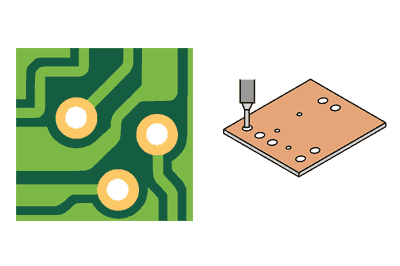We continue with our section dedicated to PCB design by looking at some notions of how a PCB is manufactured. Although it is not really necessary to design PCBs, it is convenient to have at least a slight knowledge of the PCB manufacturing process.
We say slightly, because we are only going to see a general and summarized idea of the manufacturing process. The complete process is a complex industrial process with multiple stages and baths that can also have variations.
However, and within our intention to demystify and “lose the fear” of PCBs, we cannot ignore the manufacturing process. The goal is to have a certain knowledge, so that PCBs are not “that magical thing that is manufactured by who knows how”.
We are going to focus only on the process for 2-layer PCBs, which as we know are very common and the ones we will use at home most frequently. However, the process for PCBs with more layers would be similar, but incorporating a greater number of stages for the intermediate layers.
So let’s take a look at this great and conceptually simple manufacturing process (of course, in practice it is quite complex) and that requires multiple stages perfectly orchestrated to achieve a quality product.
Manufacturing of a 2-layer PCB
We begin this review of the manufacturing process with the lamination of the material, consisting of adhering the upper and lower layers of copper by applying temperature and pressure (of the order of 200º and 25 atmospheres).
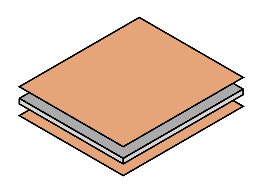
Next, the perforations are made (both holes, vias, pads for PTH components) on the board. These perforations can be made either by a CNC mill or by laser cutting.
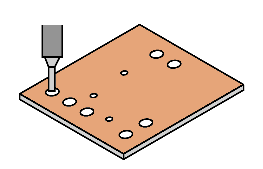
Once the board is perforated, a non-electrical deposition process is carried out. This coats the walls of the hole with a thin layer of copper, of the order of microns, which connects the top layer to the bottom layer.
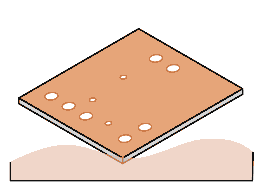
On the other hand, through high-precision printers, transparent sheets or films are generated, containing the design of the circuit we want to manufacture.
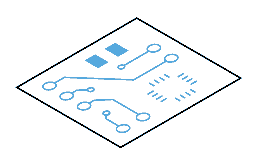
It is worth noting that the manufacturing process of the internal and external layers is slightly different. Specifically, the printed films are transparent in the areas we want to eliminate in the internal layers, and vice versa for the external layers.
Returning to our board, a photosensitive layer is applied. On this, the previous transparent film containing the circuit design is placed, ensuring that all layers are perfectly aligned.
Next, the design is transferred to the board through insulation. For this, it is exposed to a powerful ultraviolet light, which hardens the photosensitive layer only in the areas where the film is transparent.
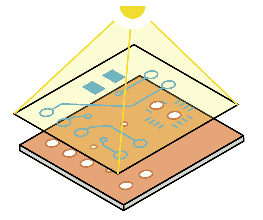
Then the board is immersed in a series of chemical baths that remove the remains of the photosensitive layer and the copper from the areas we want to eliminate, leaving only the areas corresponding to the circuits.
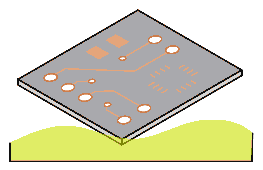
Next, the protection layer or Soldermask is applied. Typically, ultraviolet light is also used to prevent certain parts (the ones that will remain solderable) from being covered by the Soldermask.
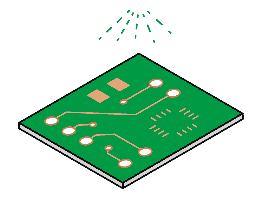
Then the board goes through a series of new baths, after which the exposed copper parts end up covered by a thin layer of tin that will facilitate the subsequent soldering of components and, in addition, protects the copper.
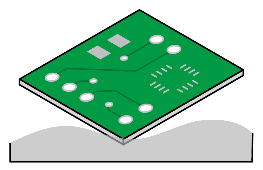
The board then goes to an ink printer, where the silkscreen is printed with texts, annotations.
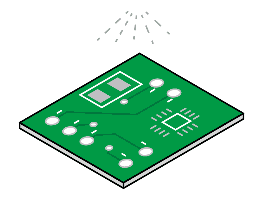
Finally, the boards are cut into their final shape in a CNC machine. Normally, PCBs are manufactured on larger boards, which contain several designs. This process also divides the overall board into the individual PCBs.
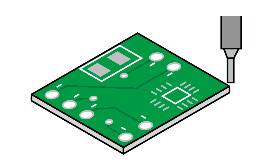
In summary
So, in summary, this is the basic process of building a PCB. As we can see, it is a process with multiple stages, but it is enough for us to focus on the most relevant points.
- The transfer of the model is done by photo transfer using two sheets, a photosensitive one applied to the board and another transparent one containing the circuit design.
- Numerous baths are applied with different chemical substances, which deposit or eliminate the conductive materials from the areas we desire.
- There are other mechanical processes such as perforation, silkscreen printing, and contour machining.
All these stages, properly combined, ensure that we have our small PCB in our hands. Pretty impressive, right?
And now that we have seen the basic aspects and the manufacturing of a PCB, it’s time to start talking about the components that we will mount on top, to configure our electronic circuits.
This is precisely what we will dedicate the next entry of the section to, where we will see SMD components versus PTH, and the advantages and disadvantages of each of them.
